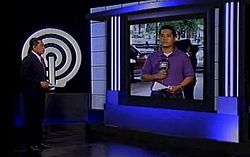TV Patrol Southern Mindanao
| TV Patrol Southern Mindanao | |
|---|---|
 Nagabalita Para sa mga Pilipino Bisan Asa sa Kalibutan | |
| Created by | ABS-CBN Regional Network Group |
| Developed by | ABS-CBN News and Current Affairs |
| Presented by |
Paul Palacio Melanie Severino |
| Country of origin | Philippines |
| Original language(s) | Cebuano |
| No. of episodes | n/a (airs daily) |
| Production | |
| Executive producer(s) | Michelle Robin |
| Running time | 30 minutes |
| Release | |
| Original network |
ABS-CBN TV-4 Davao ABS-CBN Regional Channel |
| Original release | April 17, 1989 – present |
TV Patrol Southern Mindanao (formerly TV Patrol Mindanao and TV Patrol Davao) is the local news program of the ABS-CBN Regional Network Group in Davao City. It has been the most watched news program in Davao City and Davao Region. The newscast is a tabloid-style format, and delivers news headlines about the current events in Southern Mindanao.
It is aired live daily from ABS-CBN Davao Newscenter at 5:10 PM, from Monday to Friday, simulcast on TV-24 Mati, Davao Oriental. It is also shown abroad through The Filipino Channel and on radio via DXAB Radyo Patrol 1296 Davao.
TV Patrol Southern Mindanao maintains a 24-hour shift of reporters, cameramen and drivers with coverage over the provinces of Davao del Norte, Davao del Sur, Davao Occidental, Davao Oriental and Compostela Valley.
History
As TV Patrol Mindanao (1989–1997; 2001–2005)
The program was launched on April 17, 1989, as TV Patrol Mindanao, the pioneer Cebuano language local newscast in the Mindanao area. Dante Luzon was its first anchor withAnnie Gacayan, Christina Banluta, Tina Junsay, Manny Casiple, Helen Lorenzana, Rocky Magsanoc and Bert Gorgonio as its first reportsers and was initially broadcast in Davao, Cagayan de Oro, Pagadian, Butuan, General Santos, Cotabato and Zamboanga. The language used was Cebuano. It had covered stories ranging from natural disasters, man-made disasters, religious conflicts, tribal conflicts, political controversies, social issues and crime stories in the entire Mindanao island. In 1993, Alex Santos, joined the newscast with Annie Gacayan and Bert Gorgonio. In 1994 the newscast was anchored by Art Bonjoc, Jr. In the 2001 reformat, it was anchored by Girlie Balaba (reverted to TV Patrol Mindanao) and Stephen Manangan.
As TV Patrol Davao (1997–2001)
After Luzon left the program, it was reformatted and coverage was eventually reduced as other TV Patrol regional editions were being launched in other ABS-CBN regional stations in Mindanao. Its later anchors include are Cristina Banluta, Girlie Balaba, and Aljo Bendijo (who would later anchor TV Patrol in Manila from 2001 to 2003).
As TV Patrol Southern Mindanao (2005–present)
The program was renamed to its current name in 2005. In 2006, Dante Luzon returned to the regional newscast as an alternate anchor. In 2007, Stephen Manangan and Melanie Severino became the main anchors.

On November 15, 2010, Paul Palacio took over the vacant anchor chair. The newscast had later introduced once again their new logo and set, making them the first regional group to do so since TV Patrol revamped a week earlier. During the 22nd Anniversary of TV Patrol Southern Mindanao, a new studio and a slight change on its opening billboard was unveiled. Augmented reality was also used for live reports, similar to that of the national TV Patrol. In May 2011, Melanie Severino returned to the newscast after a 6-month absence.
On August 19, 2013, TV Patrol Southern Mindanao updated its graphics similar to the main national newscast. On January 31, 2014, the program celebrated its 25th Anniversary, changed its opening billboard similar to the national newscast, and added a '25' to its title card.
Areas of Coverage
- Davao City
- Digos City
- Tagum City
- Panabo City
- Mati City
- Malita
- Nabunturan
- Island Garden City of Samal
- Davao del Norte
- Davao del Sur
- Davao Occidental
- Davao Oriental
- Compostela Valley
Current Anchors
- Paul Palacio (2010–present)
- Melanie Severino (2005–present)
Current Reporters
- Bonna Pamplona
- Vina Araneta-Pilapil - Sit in Anchor for Melanie Severino
- Rodirey Salas
- Claire Cornelio
- Hernel Tocmo - Sit in Anchor for Paul Palacio
- Francis Magbanua
- Elric Ayop
- Ara Casas
- Angelo Caballero
Segments
- Green Patrol - Environmental News
- Ronda Patrol - Police Reports
- Sports Patrol - Sports News
- Star Patrol - Entertainment News
- Bantay Patrol - Citizen's News
Former Anchors
- Girlie Balaba (1997-2002)
- Aljo Bendijo (1997-2001; now with DZAR and PTV)
- Alex Santos (1993-1996; now with DWIZ)
- Annie Gacayan (1989-1996)
- Cristina Banluta (1989-1995)
- Tina Junsay (1989-1999)
- Dante Luzon (1989, 2006-2007; relief anchor for Stephen Manangan)
- Atty. Melissa Suarez (2006)
- Art Bonjoc Jr. (1994-1997)
- Bert Gorgonio† (1989-1994, 2000-2001; as relief anchor)
- Manny Casiple (1989-1995)
- Stephen Manangan (2001-2009)
- Ad Roel Alcober (2010-2012; as relief anchor)
Previous Reporters
- Aljo Bendijo
- Manny Casiple
- Bert Gorgonio
- Tina Junsay
- Cristina Banluta
- Annie Gacayan
- Alex Santos
- Ben Tesiorna
- Girlie Balaba
- Ethel Cantor
- Helen Lorenzana
- Rocky Magsanoc
- Art Bonjoc
- Darios Relatado (currently program manager for GMA News and Public Affairs Davao)
- Robert Borje
- PJ dela Peña (currently an anchor of TV Patrol Northern Mindanao)
- Cheche Diabordo
- Charisse Dagohoy
- Kharen Serra
- Jun Tariman (presently a reporter of CNN Philippines)
- Vincent Virtucio
- Brix Pansacala
- Mikael Aparri
- Dimple Lupina
- Paolo Anota (currently a reporter of TV5 Davao)
- Pamela Gonzales
- Anette Maligad
- Jorge Ungab
- Kristin Cutin
- Gem Avanceña-Arenas (currently a reporter of TV5 Davao)
- Joel Ramirez (transferred to ABS-CBN Cagayan de Oro then in the future ABS-CBN General Santos)
- Diana Juaban
- Darlene dela Cruz
- Danjo Revilla (currently a future reporter of TV Patrol Chavacano)
Awards and Recognitions
Ateneo de Davao University Tao Awards
- Favorite Local News Anchor – Stephen Manangan
- TV Patrol Southern Mindanao – Favorite Local TV Newscast
Source:[1]
See also
- TV Patrol
- ABS-CBN Regional Network Group
- Maayong Buntag Mindanao
- DXAS-TV
- DXAB
- MAG TV Na, Mag Negosyo Ta!
- Kapamilya, Mas Winner Ka!
References
- ↑ http://www.bunsoimagazine.com/2009/03/addu-tao-awards-2009-scrutinized.html ADDU Tao Awards 2009, Scrutinized